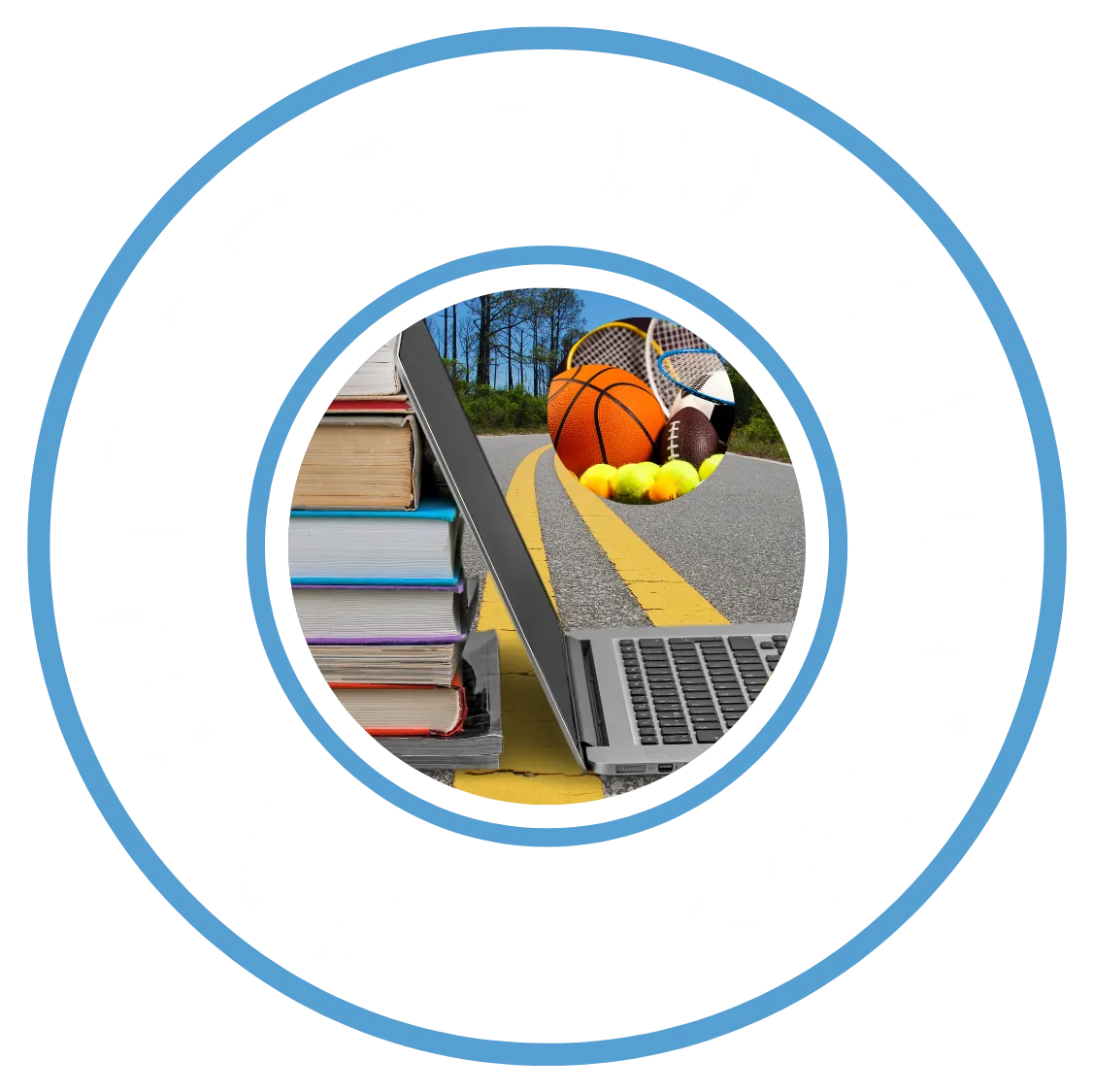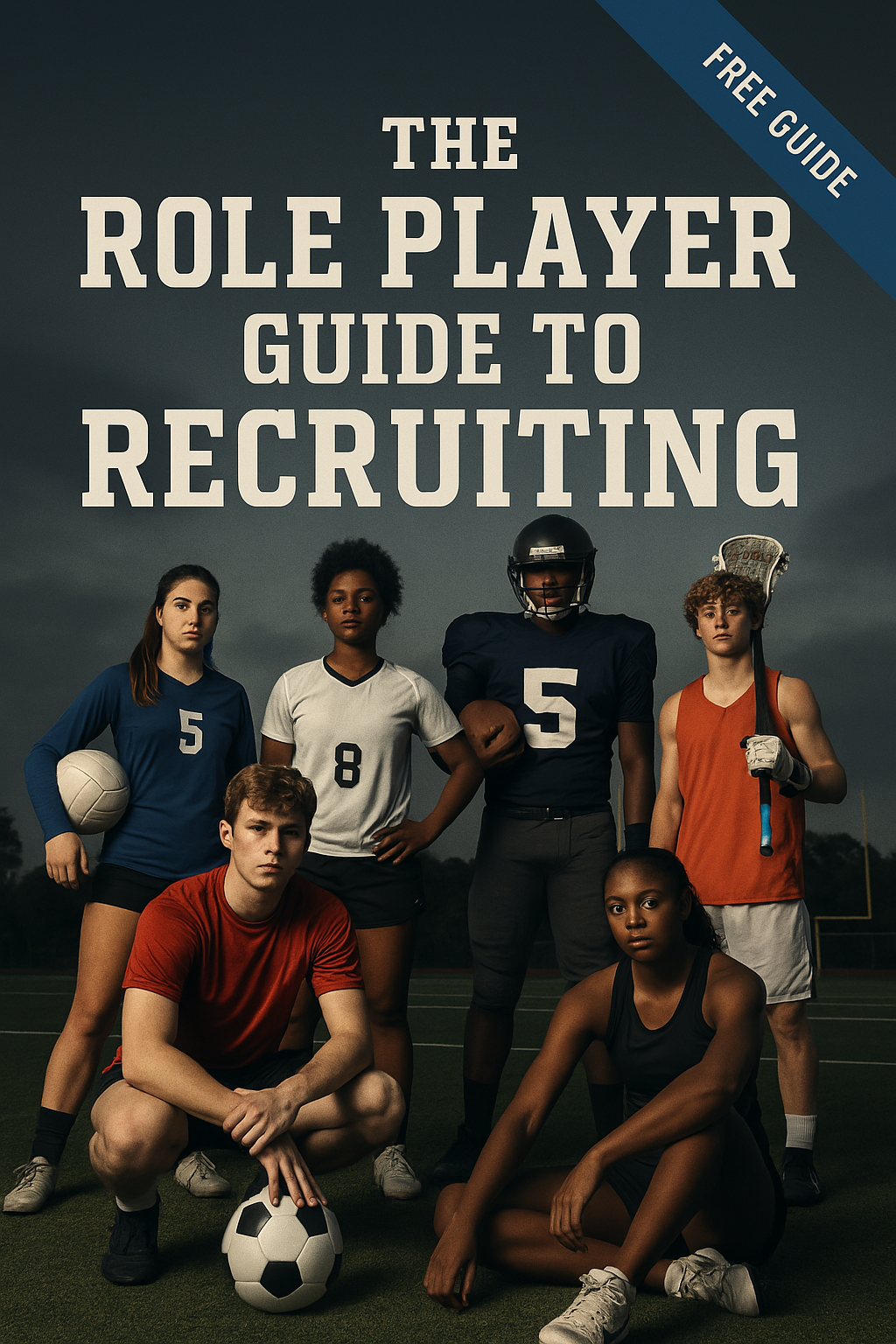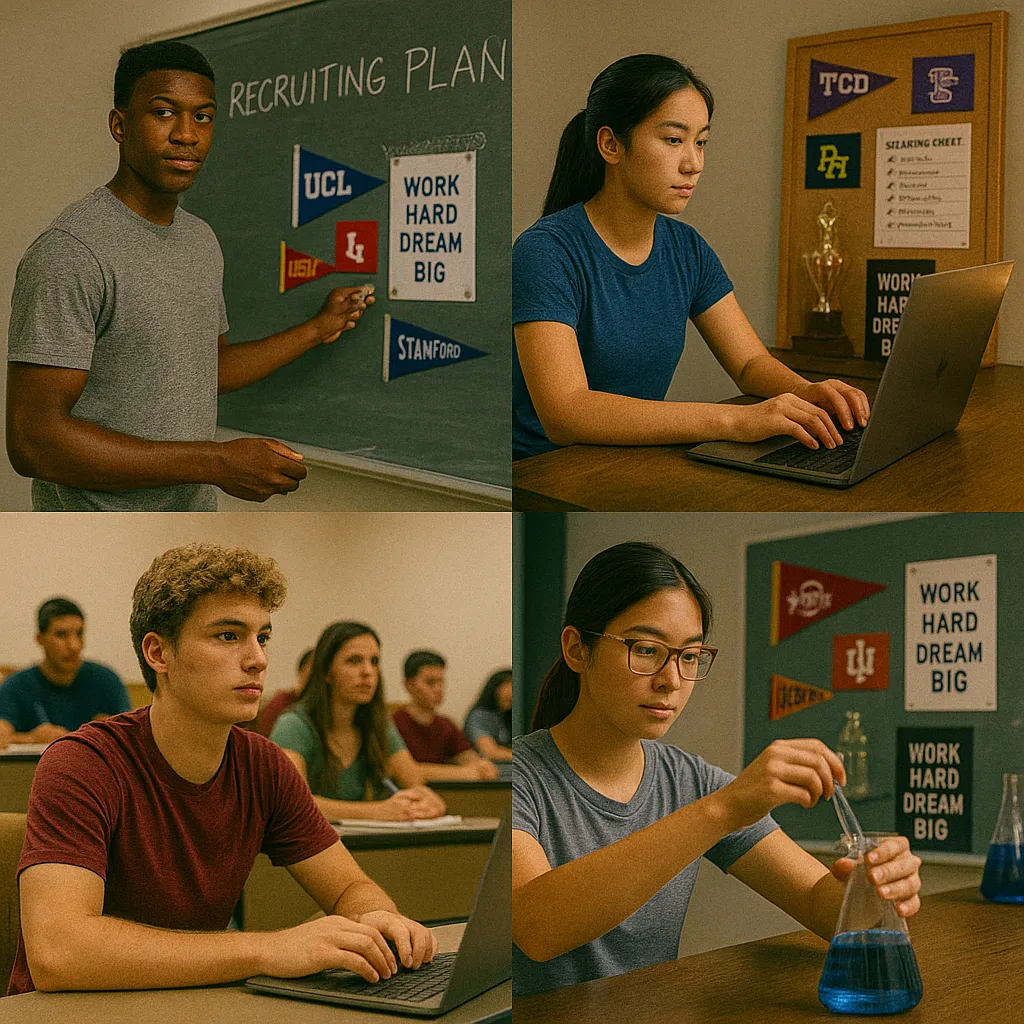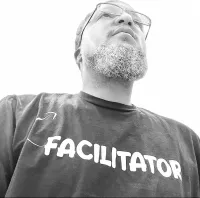

Your Success, Our Priority
Browse our articles below
Make sure to request our FREE Role Player Guide to Recruiting
WHILE SUPPLIES Last!!!
🏀⚽🏐🏈⚾🎾🏒🏊♂️🥍🎽 Free Download: The Role Player Guide to Recruiting
Not a star? Not a problem.
Whether you’re passing, blocking, digging, assisting, or just bringing relentless energy from the sidelines, this guide was created for athletes like you.
The recruiting world often highlights the MVPs and stat-sheet stuffers. Colleges also recruit role players, those who lead quietly, contribute consistently, and do what their team needs most.
This free guide gives you the tools to stand out and get recruited process started, no matter what sport you play.
🙌 This Guide Is Built For:
Athletes in basketball, soccer, volleyball, football, baseball, softball, lacrosse, track & field, cross country, tennis, hockey, wrestling, cheer, swimming, field hockey, and more. Defenders, passers, relays, utility players, blockers, reserves, bench leaders. Student-athletes who want to lead, even without the spotlight. Parents and coaches who want to support without burnout
💥 Why It Works:
Because colleges do not build teams with just stars, they build them with
contributors.
And many of the most successful college athletes were once role players who outworked the hype.

Here's what you get:

✅ How to stand out as a role player in any sport
✅ Tips for gaining exposure—even if you’re not the starter
✅ Scripts & strategies to communicate with college coaches
✅ Sport-adaptable advice and mental performance boosters
✅ A full action plan to move your recruiting process forward
By checking this box, I consent to receive both transactional and marketing communications from this organization. This includes messages related to my account, orders, appointment reminders, special offers, promotions, and other relevant updates. Message frequency may vary. Message and data rates may apply. Reply HELP for help or DELETE to opt out at any time.
Click the more stories button for additional articles

Level Up Your Athletic Recruiting IQ
Level Up Your Athletic Recruiting IQ with the Right System
Recruiting is not a guessing game. Every student-athlete, parent, and coach knows the stakes are high, but only those who understand the process truly stand out. Athletic recruiting rewards those who approach it like a strategy game: knowing the system, tracking progress, and using the right tools to get noticed. Growth happens when awareness meets action, and those who commit to learning the recruiting process find themselves playing smarter and achieving more. This article breaks down how to build a standout student-athlete profile, leverage recruiting software, and use proven college exposure tools to play bigger in the high school recruiting system. The goal is to give you clear, practical insights and steps for navigating the recruiting timeline with confidence and clarity.
What Sets a Strong Student-Athlete Profile Apart?
A student-athlete profile is more than stats and awards. Coaches look for a complete picture, academic records, athletic achievements, highlights, and character references. A high-impact profile tells a story that goes beyond numbers, showing how an athlete contributes to a team, handles adversity, and balances academics with sports. The profile should be updated regularly, reflecting both growth and recent accomplishments. When college coaches review hundreds of profiles, the ones that show a well-rounded, disciplined, and self-aware athlete always rise to the top.
To make a profile stand out, include:
Current academic transcripts and test scores
Verified athletic stats and video highlights
Personal statement detailing goals, values, and motivation
Honors, leadership roles, and community involvement
Contact information for coaches and references
Profiles are not static documents. They evolve as the athlete progresses. Keeping it fresh signals to coaches that the student-athlete is committed and engaged in their own journey.
How Does Recruiting Software Give You an Edge?
Recruiting software has shifted the balance from luck to strategy. Platforms designed for athletic recruiting streamline the process, making it easier to organize data, track communication, and manage timelines. Student-athletes and families gain access to dashboards that monitor college interest, deadlines, and next steps. Coaches benefit from tools that sort prospects, filter by academic or athletic criteria, and simplify outreach.
The biggest advantage? Transparency. Everyone involved can see where they stand in the recruiting process. Families reduce stress by having a clear recruiting timeline, while coaches appreciate efficient communication and accurate information. The right recruiting software saves hours of manual work and reduces the risk of missing critical opportunities.
When selecting a platform, look for features like:
Customizable student-athlete profiles
Automated reminders for recruiting milestones
Secure document upload and sharing
Integrated communication tools
Analytics to track exposure and engagement
Choosing the right software can be the difference between getting noticed and getting lost in the shuffle.
What Are the Keys to Standing Out in College Exposure?
Exposure is the currency of athletic recruiting. No matter how talented an athlete is, limited exposure means fewer opportunities. College exposure tools, from online platforms to showcase events, amplify visibility for student-athletes. The best results come when athletes are proactive, consistently sharing video highlights, academic updates, and schedules with coaches who are a fit for their goals.
Direct outreach works. Sending personalized messages, sharing updated film, and attending targeted showcases all boost the odds of getting on a coach’s radar. Athletes should use exposure tools to build relationships, not just collect digital badges. Quality communication, prompt responses, and professionalism set recruits apart. The goal is not just to be seen, but to be remembered for the right reasons.
How Does the High School Recruiting System Operate?
The high school recruiting system can feel complex but operates on clear principles. College coaches rely on a network of high school coaches, club programs, and digital platforms to identify prospects. Early engagement, consistent performance, and academic eligibility all shape an athlete’s path through the system. The process rewards those who do their homework, researching programs, understanding scholarship requirements, and staying organized.
Many families underestimate the value of a structured approach. Setting reminders for key deadlines, logging coach communications, and tracking progress are all part of a high school recruiting system that works. Student-athletes who treat their recruiting journey like a project, with tasks, benchmarks, and feedback, find more clarity and less frustration.
What Should You Know About the Recruiting Timeline?
The recruiting timeline is not the same for every sport or division, but certain phases apply across the board. Early awareness leads to better planning. Understanding when coaches can contact athletes, when official visits are allowed, and when commitments can be made shapes every decision. Missing a key window can set back an entire recruiting season.
Key phases typically include:
Discovery: Researching colleges, building lists, starting communication
Engagement: Attending camps, showcases, and responding to coaches
Decision: Evaluating offers, making visits, and finalizing choices
Transition: Preparing for college and ensuring academic eligibility
Every athlete’s recruiting journey follows a unique timeline, but tracking milestones keeps the process moving forward. For a more detailed breakdown of each recruiting phase, visit the Discovery Phase and related articles.
Why Growth Mindset Matters in Athletic Recruiting
Growth is not just about physical skills. The awareness to recognize mistakes, adapt strategies, and keep learning separates top recruits from the rest. Student-athletes who reflect on feedback and seek out resources, like recruiting software or professional guidance, accelerate their progress. Coaches look for athletes who show resilience, adaptability, and a willingness to improve every season.
Building a growth mindset means welcoming challenges and tracking incremental progress. This attitude is contagious, families, teammates, and coaches all benefit when the recruiting journey is about more than just offers. Growth happens when athletes stay curious, own their process, and remain open to new opportunities.
How Can Parents and Coaches Support the Process?
Parents and coaches play a critical role in the recruiting ecosystem. Their support shapes how athletes respond to setbacks, organize their time, and present themselves to college programs. The best outcomes come when adults provide structure, encourage independence, and keep expectations realistic.
Practical steps for parents and coaches include:
Helping athletes set schedules and stick to recruiting timelines
Reviewing student-athlete profiles for accuracy and completeness
Coaching communication skills for emails and phone calls with recruiters
Providing honest feedback after camps or showcases
Staying informed about eligibility and scholarship rules
Guidance from trusted adults keeps student-athletes focused and motivated, especially during setbacks or periods of uncertainty.
What Pitfalls Can Stall Your Recruiting Progress?
Recruiting is rarely a straight line. Common pitfalls include missed deadlines, incomplete profiles, and lack of follow-up with coaches. Overreliance on highlight videos, ignoring academic requirements, or sending generic messages all limit opportunities. Staying proactive and detail-oriented helps avoid these setbacks.
Student-athletes should also be wary of expensive recruiting services that promise shortcuts. Results come from consistent effort, honest self-assessment, and using proven tools, not from flashy marketing. For a reality check on common myths and mistakes, see Expensive Recruiting Services.
Action Steps for Smarter Recruiting
Every athlete can take control of their recruiting journey by focusing on a few key action steps. Start by building a comprehensive student-athlete profile, then select recruiting software that fits your needs. Stay engaged with college exposure tools, and never overlook the value of deadlines and consistent communication.
Recommended steps include:
Audit and update your student-athlete profile monthly
Set up a recruiting dashboard or planner to track milestones
Reach out to target programs with tailored messages and highlight videos
Schedule check-ins with your coach or mentor for feedback
Read more about the recruiting process at the FTP Information Portal
Commitment to these steps signals to coaches and programs that the athlete is serious, organized, and ready for the next level.
Recruiting IQ: The Real Competitive Advantage
Growth in athletic recruiting starts with understanding the process and using every available resource to your advantage. The student-athletes who learn the system, stay aware of their progress, and play smarter always find new ways to stand out. The recruiting journey rewards those who blend discipline with creativity, using both data and self-awareness to attract the right opportunities. As the system evolves, those who stay curious, adapt quickly, and own their process will shape the future of college sports. That’s where real winning begins.
Resources & Community
🎯
Follow Facilitate The Process on Facebook
https://www.facebook.com/facilitatetheprocess/
🌐
Join Our Recruiting Community
🔗
Get Started Today

